Back to Okia Flat, this time with two objectives in mind! First off, I wanted to take advantage of the beautiful weather and take some pictures from the top of the little pyramid.
 With that in mind, I swerved right as soon as I entered the reserve, and set off up the steep narrow path that would take me to the summit of the pyramid. As I climbed I noticed the occasional skittering noise in the bushes, and finally caught a culprit in the act.
With that in mind, I swerved right as soon as I entered the reserve, and set off up the steep narrow path that would take me to the summit of the pyramid. As I climbed I noticed the occasional skittering noise in the bushes, and finally caught a culprit in the act.
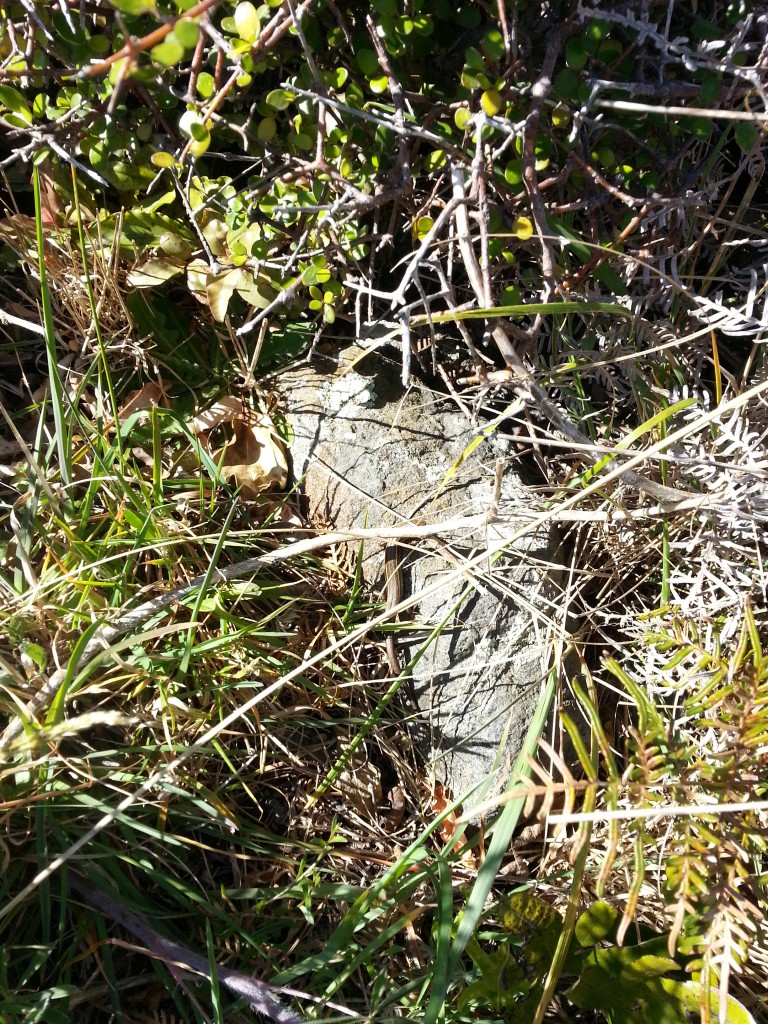
A few more minutes climb brought me to the summit, thoroughly out of breath. The view however did not disappoint. To my left was the bulk of the big pyramid, while behind me lay farm land and a winding brook reflecting the sky. Ahead the wetlands unfolded, bronze bracken criss-crossed by walking tracks and fire breaks.

Now to the second reason for my visit. I’ve long been aware of the small cave at the base of the pyramid, but it seems there’s more to it than I ever knew. During the course of my research for previous stories on this blog, I’d recently stumbled upon an intriguing article describing several archaeological examinations of the cave which took place in 1938. The article describes the cave as having two entrances, an upper and a lower one – news to me, as I’d always thought the apparent back wall of the ground level entrance was all there was to it.
So, from my vantage point at the peak of the pyramid, I looked down on the spur under which the lower entrance of the cave was hidden. I couldn’t see any evidence of a higher exit, but the article had said that it was well hidden.
So I carefully made my way back down the steep path through the scrub and purple flowers.

I circled the base of the pyramid until I could see the ground-level cave entrance beyond a wall of thick grass and scrub. Luckily a handy trail had been trampled by previous visitors, leading me directly to the high arch of the cave.
There was indeed a short tunnel with a ceiling that sloped sharply down towards the brown stagnant water that filled the floor of the cave. It certainly didn’t look as if there was anything more to it than that.
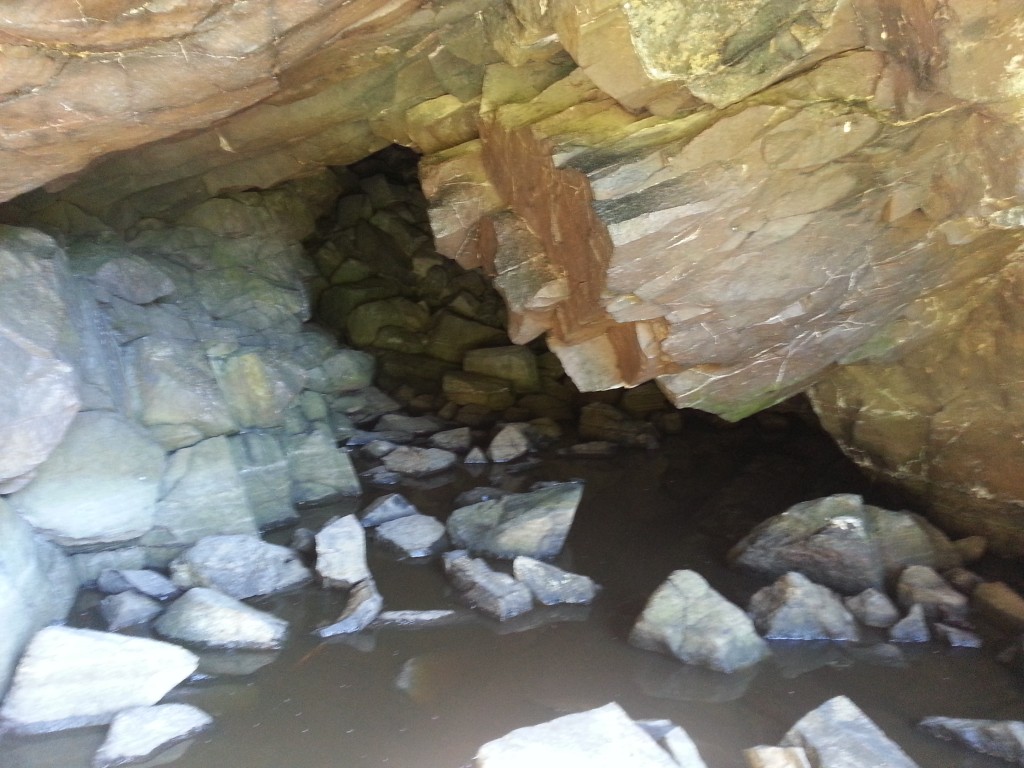
I used the fallen rocks as stepping stones to investigate further and found that I could indeed slip around the low ceiling and into a cavern beyond. Out of the heat and the sun, it was cool, quiet and dry. The vaulted ceiling of geometric basalt columns put me in mind of a buried church, while the floor was a landslide of fallen boulders leading up towards a narrow patch of light.
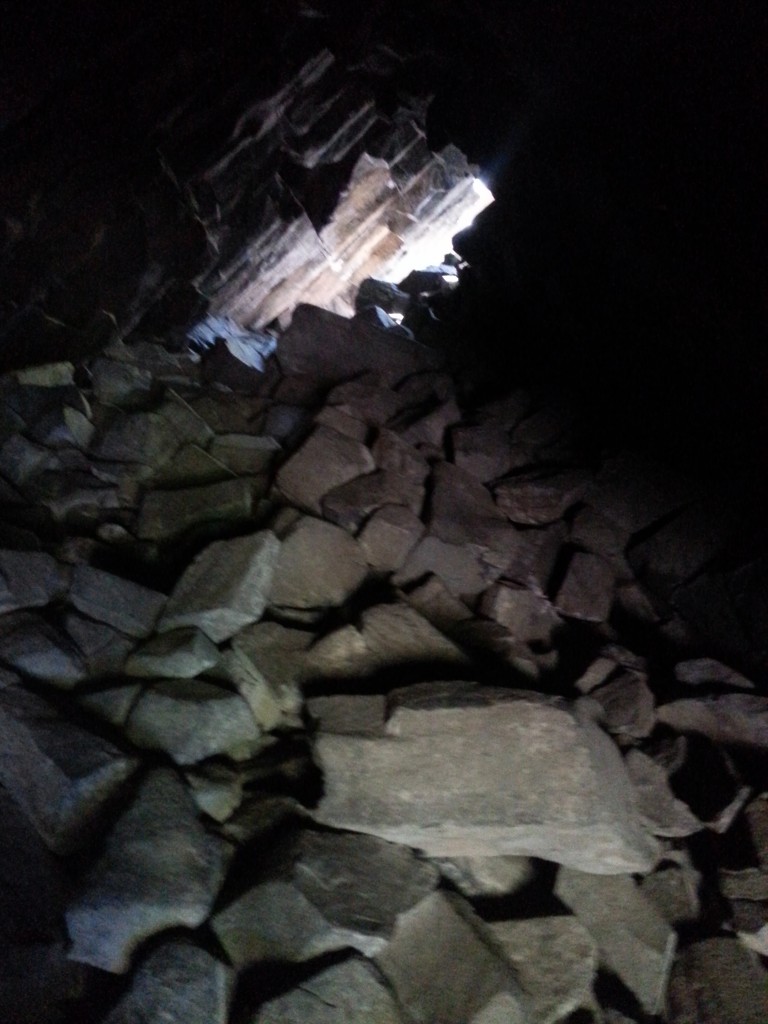
If you took the time to click away to the article I mentioned above, you’ll know that several artefacts were discovered in this cave. The most important was a wooden god-figure which is now on display at the Otago Museum, but there were also some sleeping mats, shells and animal bones, and…human remains.
The archaeologist received some information that the human bones he found (along with several skulls that had been discovered previously) belonged to the victims of an attack by the warrior Te Wera, who were then cannibalised. Atholl Anderson’s book The Welcome of Strangers (available at the Dunedin Public Library) does note that a figure named Te Wera was involved in several attacks on the Peninsula, including an ambush in the Papanui area, although I’m not sure whether this is the same incident, or even the same Te Wera (there were several!). Anderson also tells of another massacre that took place at Okia Flat, part of an ongoing dispute between the residents of Pukekura (at Taiaroa Head) and the people of Papanui Inlet that began over fishing rights and spiralled into spellcasting, sabotage and murder.
As I clambered up the heap of fallen rock, I couldn’t help but wonder what might still be hidden below. Ancient artefacts? Skeletal remains? Spiders? That was enough to spur me on towards the light.
I emerged from a small hole in the face of the pyramid and into the light.

Behind me rose a sheer wall of basalt.

It looked like I might be able to climb back down from this point, but my way was barred by some native stinging nettle. Although I’m aware its deadly reputation is slightly overblown – there has only been one recorded death from native nettle stings – I wasn’t keen to experience it personally. Since I couldn’t go forward and couldn’t go over, it was back into the darkness for me.
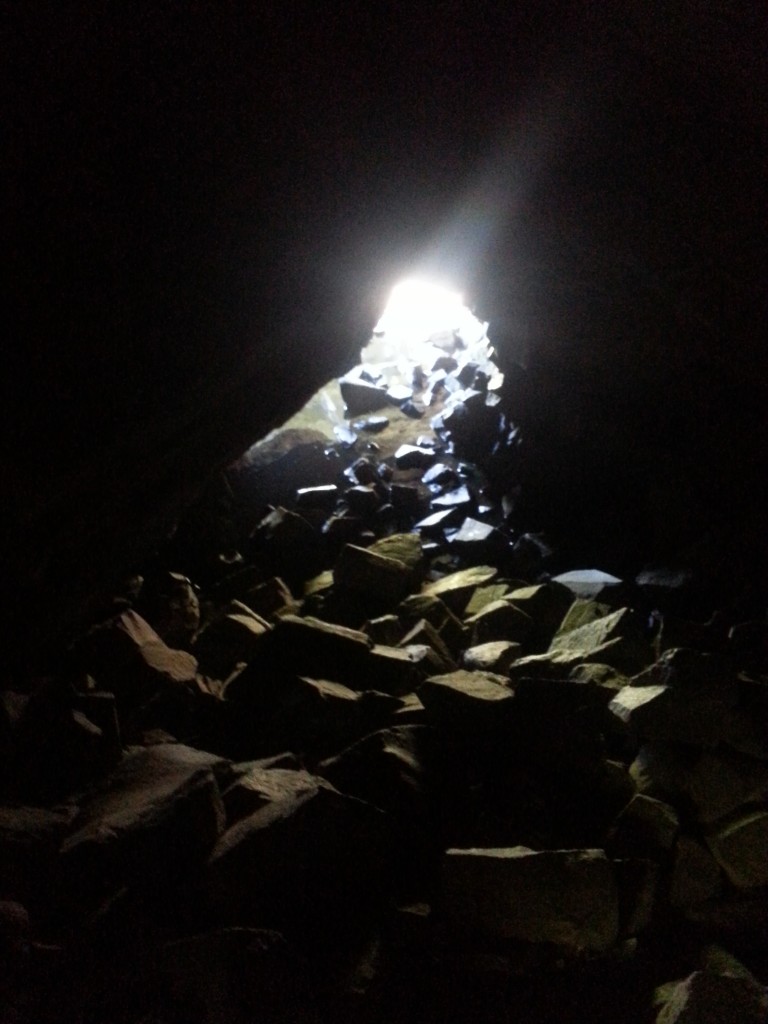
I scrambled back down the slope and over the stepping stones just in time to meet up with Dad, who was puzzling over my disappearance.
We decided to take the loop walk, so we headed off past the large pyramid (but not without examining it carefully for any sign of a path to the top), past the cabbage tree slope, and towards the huge basalt cliff topped by a plateau of farmland. Nearby is a small rocky outcrop, which I have previously remarked looks disconcertingly man-made.
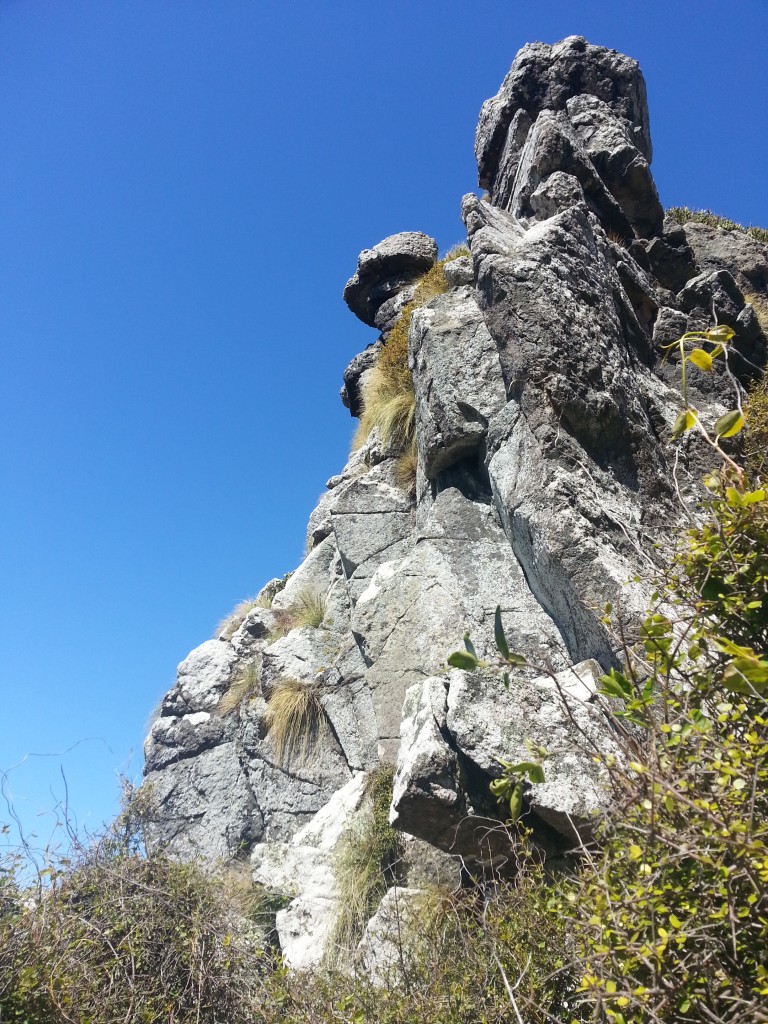
We passed by the Penguin Trust diligently checking their traps, and through fields of flowering yellow lupins.

We ate our snacks on Victory Beach before completing our loop. Along the way, we spotted several small birds with bright yellow heads and chests, which we later confirmed were yellowhammers.
Our objectives achieved, we left the reserve, leaving the little pyramid’s dark secret for the next adventurer to discover.
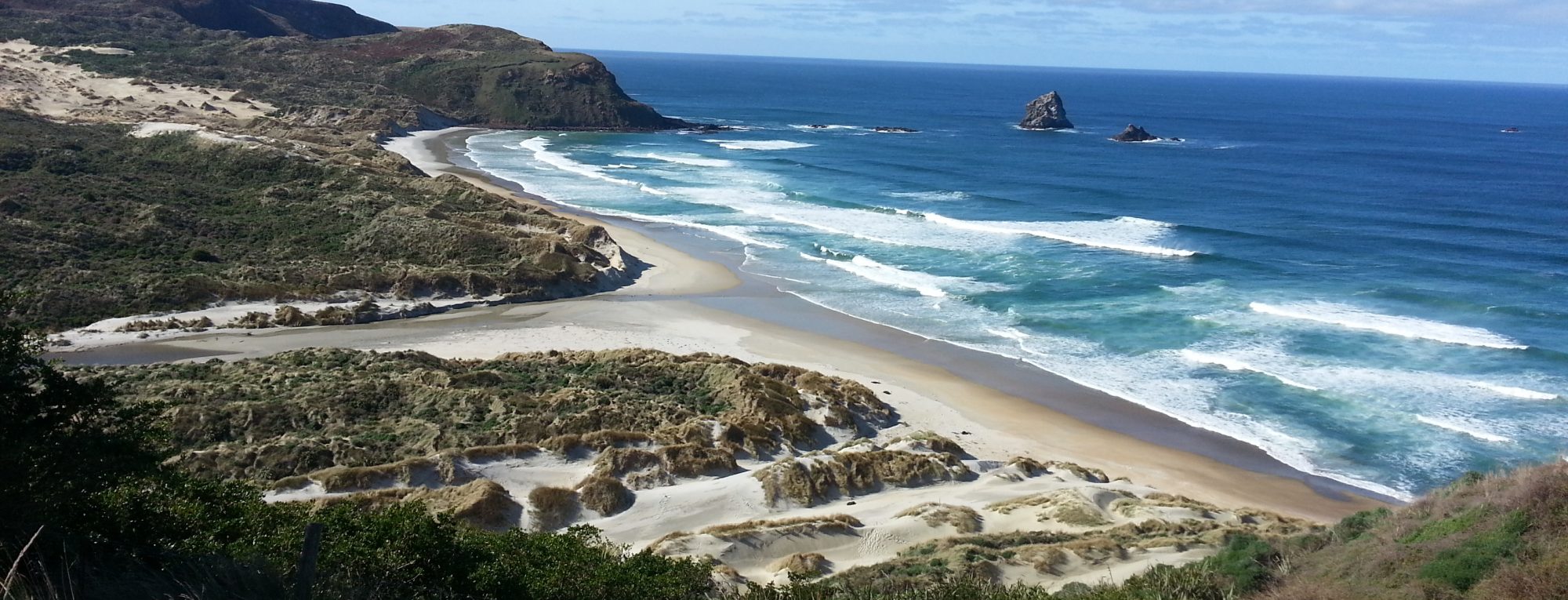
Thank you for such informative articles. I have often visited many of the places you write about but I’ve not known the deeper history behind them. Please keep up the good work. I look forward to future articles.
Thanks Gael for your kind feedback!
Hi, Would you have a picture or be able to describe the wooden god-figure?
Hi Sharon, you can find it at the Otago Museum if you’re a local. I haven’t got a picture of it myself.
Hi there what n interesting article , well written too! I’d love to read the ‘intriguing article’ that was attached but it bounced back error site not found etc.. do you know how I could access this to read it?
Excellent work must go and explore the site ourselves sometime, much more to nzs past than is traditionally known for sure!
I’ve found the intriguing article:
EXCAVATION OF CAVE ON OKIA FLAT, WICKLIFFE BAY
http://www.jps.auckland.ac.nz/document//Volume_49_1940/Volume_49%2C_No._193/Excavation_of_cave_on_Okia_flat%2C_Wickliffe_Bay%2C_by_Ellis_D._Sinclair%2C_p_137-143/p1